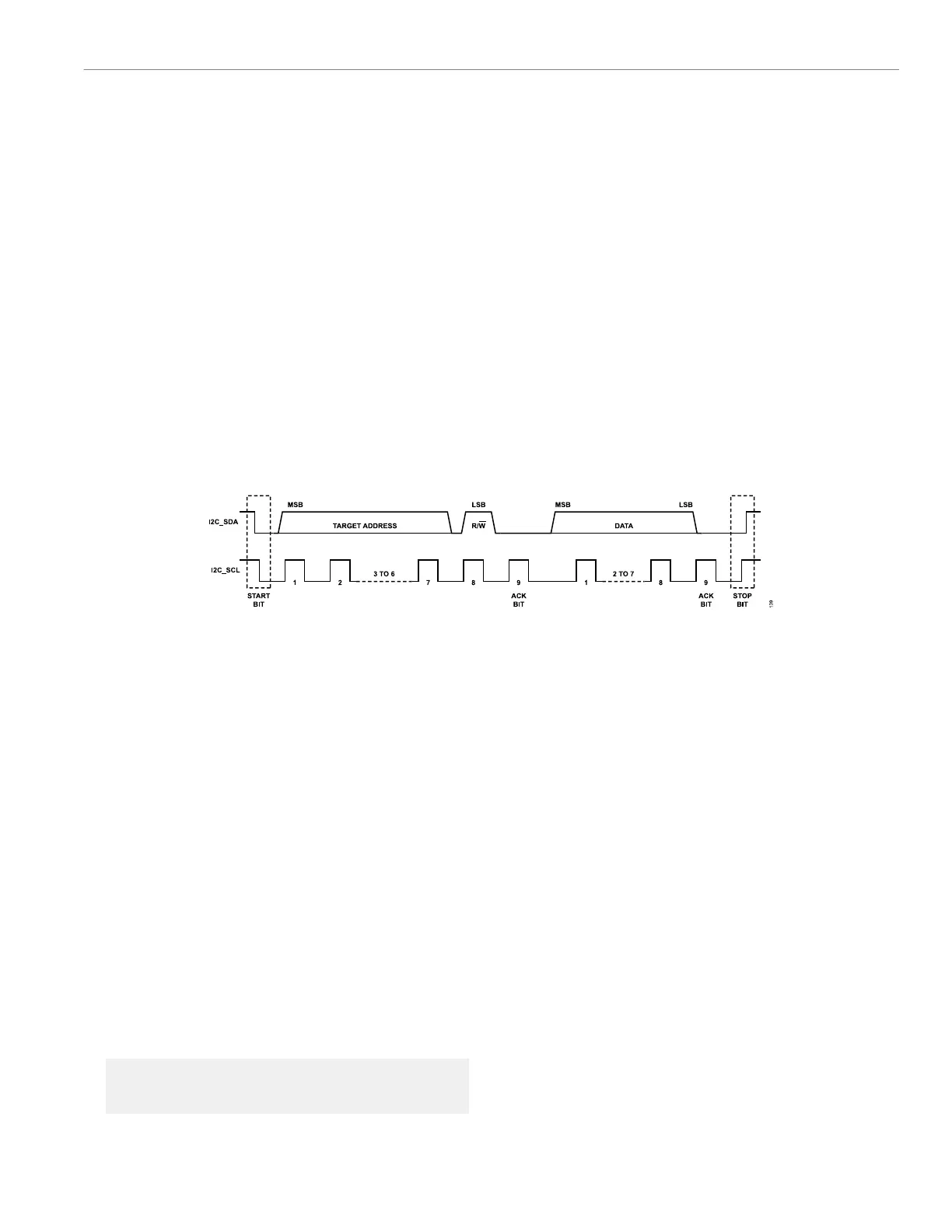Reference Manual ADuCM356
I
2
C SERIAL INTERFACE
analog.com Rev. A | 221 of 312
I
2
C FEATURES
The I
2
C interface features an initiator or target mode with 2-byte
transmit and receive FIFOs. The I
2
C interface supports 7-bit and
10-bit addressing modes, either as four 7-bit device addresses or
a combination of one 10-bit address and two 7-bit addresses in
the target with repeated starts in initiator and target modes. Other
devices on the bus can enable clock stretching without causing any
issues with the ADuCM356. Initiator arbitration, continuous read
mode for the initiator or up to 512 bytes, fixed read, and internal
and external loopback are also available.
Support for DMA in initiator and target modes is provided by the
DMA controller, as well as software control on the target of the no
acknowledge signal.
I
2
C OVERVIEW
The I
2
C data transfer uses a serial clock pin (I2C_SCL) and a serial
data pin (I2C_SDA). These pins are configured in a wire-AND’ed
gated format that allows arbitration in a multiinitiator system.
The transfer sequence of the I
2
C system is initiated by an initiator
device, which generates a start condition while the bus is idle. The
initiator transmits the target device address and the direction of the
data transfer during the initial address transfer. If the initiator does
not lose arbitration and the target acknowledges the initial address
transfer, the data transfer is initiated. This transfer continues until
the initiator issues a stop condition and the bus becomes idle.
Figure 57 shows a typical I
2
C transfer.
An initiator device can be configured to generate the serial clock.
The frequency is programmed by the user in the serial clock divisor
register, DIV. The initiator channel can be set to operate in fast
mode (400 kHz) or standard mode (100 kHz).
Figure 57. Typical I
2
C Transfer Sequence
The user programs the I
2
C bus peripheral address in the I
2
C bus
system. This ID can be modified any time a transfer is not in
progress. The user can set up to four target addresses that are
recognized by the peripheral. The peripheral is implemented with a
2‑byte FIFO for each transmit and receive shift register. The IRQ
and status bits in the control registers are available to signal to the
processor core when the FIFOs need to be serviced.
I
2
C OPERATION
I
2
C Startup
The following steps are required to run the I
2
C peripheral:
1. Enable PCLK to the I
2
C peripheral by setting CTL5, Bit 5
and CTL5, Bit 3 = 0. PCLK frequency is controlled via CTL1,
Bits[13:8].
2. Configure the digital pins (P0.4/I2C_SCL and P0.5/I2C_SDA)
for I
2
C operation via the GP0CON register.
3. Ensure the drive strength for the P0.4/I2C_SCL pin and P0.5/
I2C_SDA pin is increased to ensure reliable I
2
C communica-
tions, as detailed in the following example code:
GP0DS = 0x30; // Increase drive strength
of I2C pins.
4. Configure the I
2
C registers as required for target or initiator
operation.
5. Enable the I
2
C target or initiator interrupt source as required.
When using I
2
C, the user must disable the internal pull-up resistors
on the I
2
C pins via the GP0POL register. The GPIO multiplexed
configuration mode is I2C_SCL for P0.4/I2C_SCL and is I2C_SDA
for P0.5/I2C_SDA.
7-Bit Addressing
The ID0 register, ID1 register, ID2 register, and ID3 register contain
the target device IDs. The ADuCM356 compares the four IDx
registers to the address byte. To be correctly addressed, the seven
MSBs of IDx registers must be identical to that of the seven MSBs
of the first received address byte. The LSB of the IDx registers
(R/W or the transfer directional bit) is ignored in the process of
address recognition. The initiator addresses a device using the
ADR1 register.
10-Bit Addressing
This feature is enabled by setting SCTL, Bit 1 for initiator and
target mode. The 10-bit address of the target is stored in the
ID0 register and ID1 register, where the ID0 register contains the
first byte of the address, and the R/W bit and the upper five bits
must be programmed to 11110, as shown in Figure 58. The ID1

